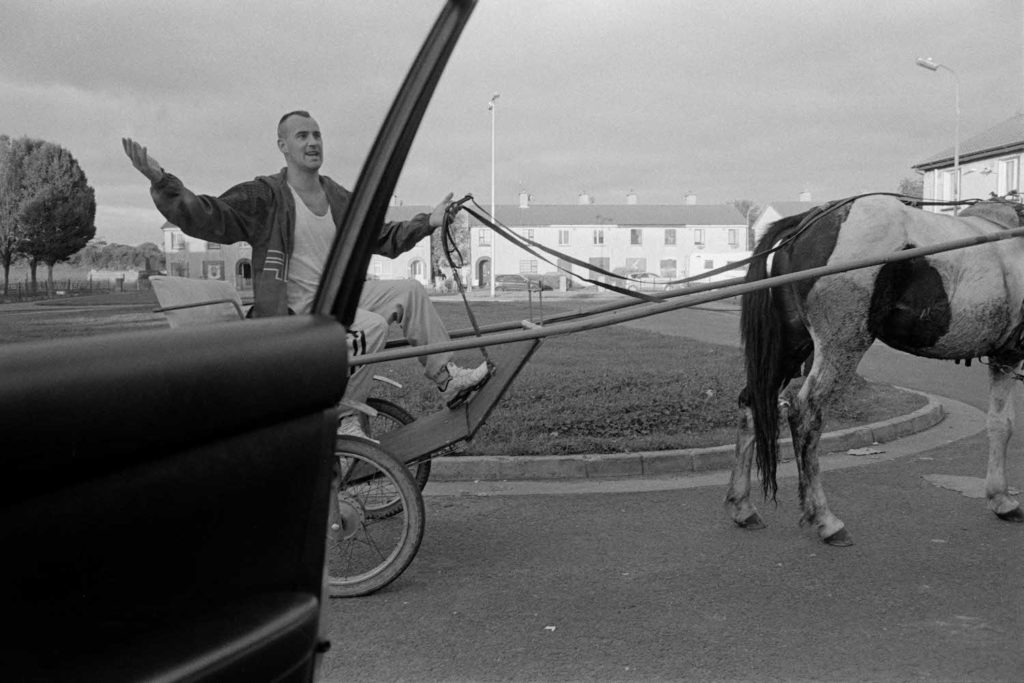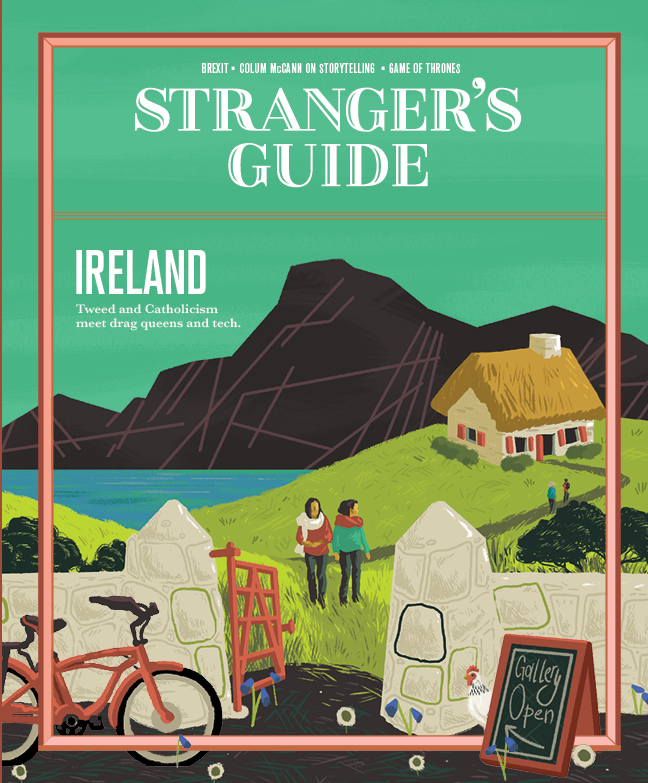
When the upstart Limerick hip-hop duo The Rubberbandits released their hit single “Horse Outside” in late 2010, the raunchy sendup of local traveller culture immediately went viral on YouTube with over 1.5 million views in five days. It has over 18 million views to date. Irish audiences may have been familiar with the group’s comedic antics from their “guide to Limerick” segment on RTÉ, but “Horse Outside” brought the Rubberbandits’ homegrown sensibilities—and Limerick accents—to a global audience. The song’s defiant refrain is delivered by a man attempting to woo a bridesmaid away from his vehicle-equipped peers at a wedding party:
“Fuck your Honda Civic, I’ve a horse outside
Fuck your Subaru, I have a horse outside
And fuck your Mitsubishi, I’ve a horse outside
If you’re lookin’ for a ride I’ve got a horse outside.”
It’s a cheeky commentary on materialism, masculinity and mobility post–2008 downturn. But the pop hit also hints at an acceptance of the end of Ireland’s “Celtic Tiger” boom times that started in 1993 and ended with the global economic crisis. After the fall, when compared to the expense of car ownership, riding a horse for transportation might have seemed newly appealing. After all, Ireland had never expected to see that kind of prosperity to begin with. As one Limerick resident had lamented to me with typical wistfulness a year earlier, “now, things will just go back to how they’re meant to be.”
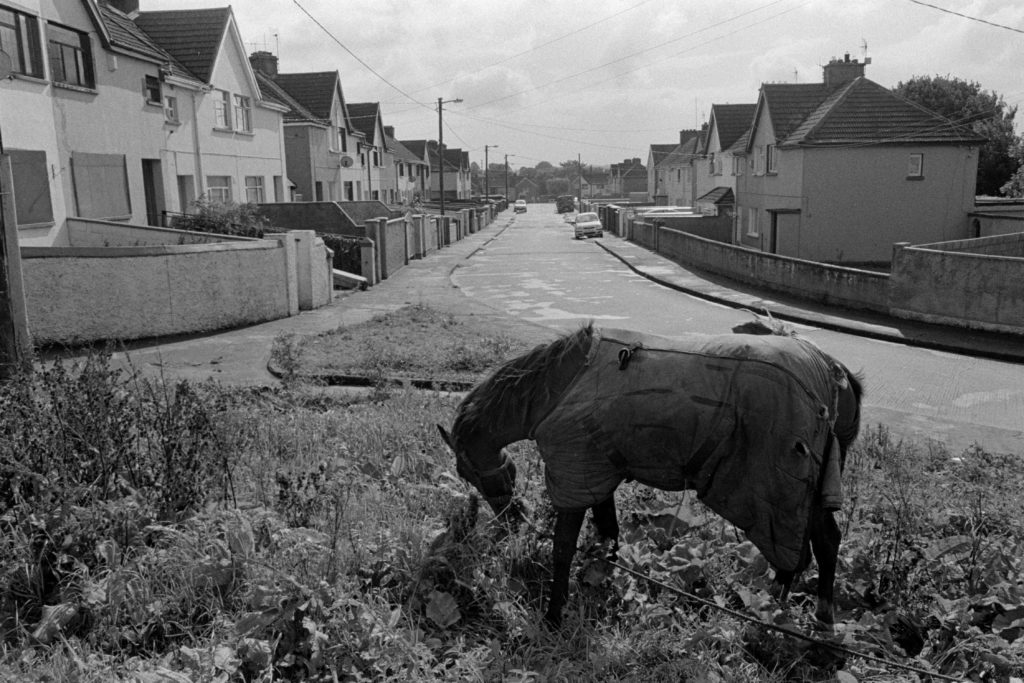
For the uninitiated, “Horse Outside” also provides a fairly realistic—if comically exaggerated—entree into an urban equine culture that has persisted, despite state efforts, in disadvantaged communities across Ireland. Indeed, in council estates from Dublin to Limerick, young men are growing up alongside horses, raising and racing them—often illegally—and carrying the torch for a traditional rural culture many centuries in the making. And despite waves of enforcement by local agencies, fining owners, rounding up horses and selling them for profit, or else destroying them outright (as Limerick City and County Council did with nearly 500 animals in 2015 and 2016), there are few signs that the pastime is wavering. In Limerick, I saw Shetland ponies grazing in vacant lots, foals frolicking on sidewalks and side alleys and full-grown stallions pulling sulkies or being ridden bareback by young men in tracksuits and trainers. In Ireland, the connection between a man and his horse is an intimate, natural right. Now, threatened by the consumerism that prosperity begets, horse ownership is one of the few remaining links to the nation’s fading agrarian heritage.
•••
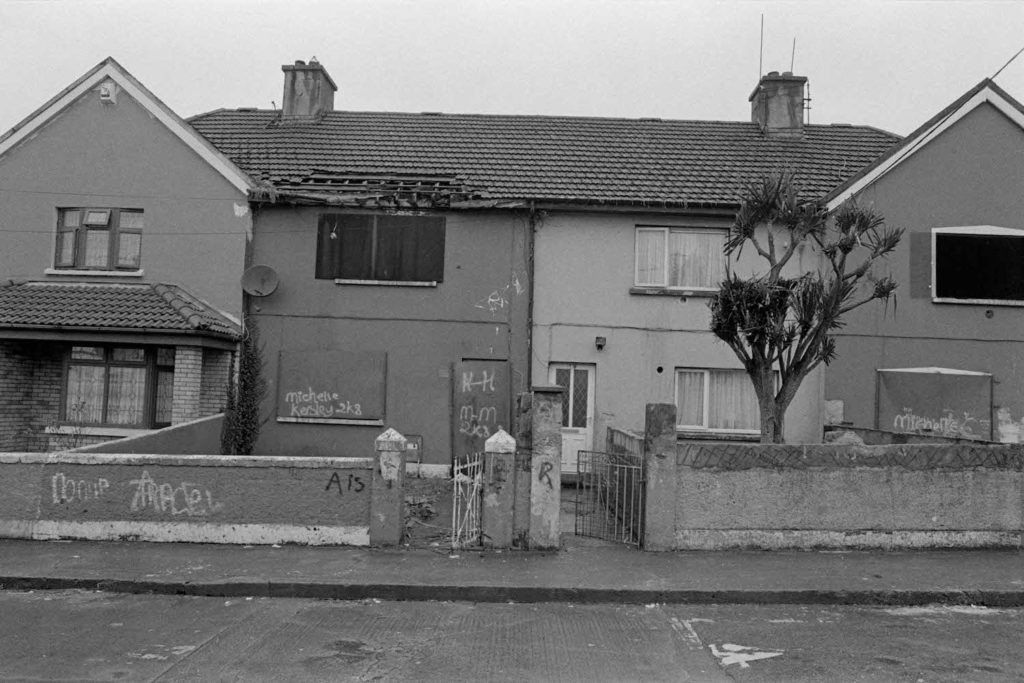
Nestled on the River Shannon, Limerick is surrounded by rolling hills that look like what most people think of when they picture Ireland: small-scale agriculture dotted with ancient castles, grass-banked waterways, one-lane roads, loads of green. But the idyllic settings mask a darker reality. “Limerick is a small town with a big-city attitude,” admits resident and local housing activist Cathal McCarthy in explanation of his city’s decades-old reputation as a hotbed for violent crime. It’s a stigmatization I had already heard epitomized in a popular pejorative for Limerick—“Stab City”—and in its unsettling distinction of having been the 2008 murder capital of Western Europe, all with a current population of a little over 90,000.
Young men are growing up alongside horses, raising and racing them—often illegally—and carrying the torch for a traditional rural culture many centuries in the making.
I’d traveled to Ireland’s third city in the summer of 2009 to photograph the progress of a controversial urban renewal project in four of the city’s notoriously blighted council estates: Moyross, Southill, St. Mary’s Park and Ballinacurra Weston. The Limerick Regeneration Project promised a complete reimagining of communities whose struggles the “good years” had done little to alleviate. In the 1930s, long-neglected neighborhoods like these provided the conditions for Frank McCourt’s Angela’s Ashes. Entering the damp interiors of some Limerick council flats nearly a century later, it appeared little had changed. Neighborhoods were corralled by cul-de-sacs and separated by walls from the larger community, with limited access to groceries, transportation and meaningful civic participation. Empty row houses were derelict shooting galleries; religious iconography was routinely vandalized. The depleted urban tableau of structural inadequacy and material need would be familiar to anyone who has spent time in American public housing projects.
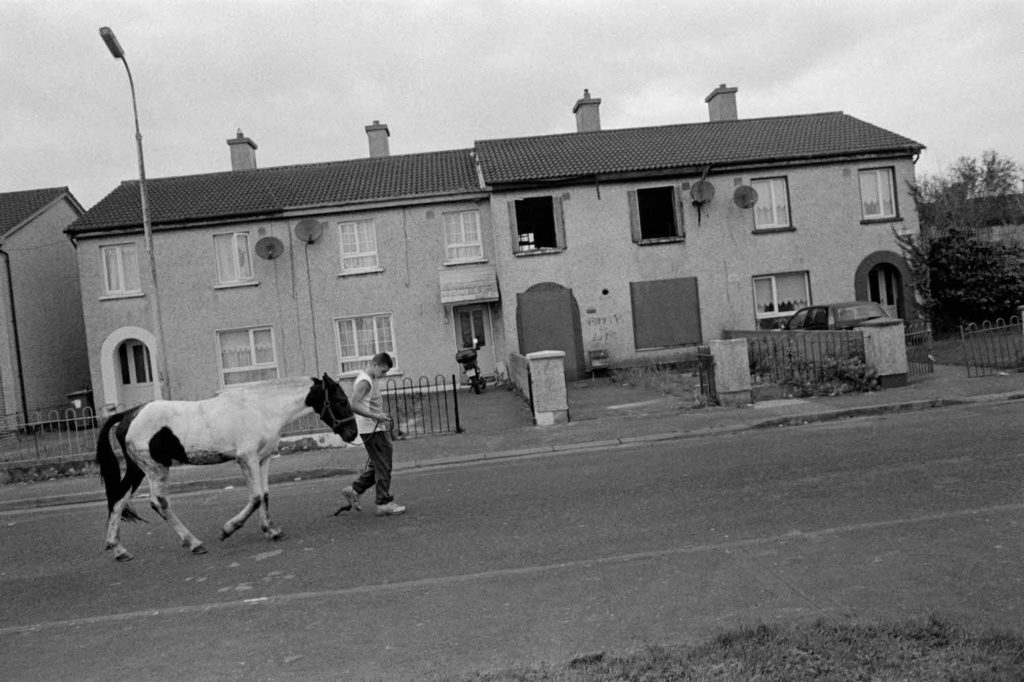
Launched in 2008, “regeneration” was a high-minded attempt to dispel those accumulative ills with one broad stroke of architectural revision. The ambitious plan called for a complete demolition and replacement of the estates with new buildings designed to foster “sustainable community.” But the €3 billion project hardly had a chance to get off the ground when the downturn hit a year later, and many locals were justifiably suspicious of the project, which—upon my arrival—had failed to erect even a single new home, though many dozens had been eagerly demolished as their inhabitants accepted early buyouts. The resultant patchwork of occupied homes interspersed with boarded-up vacants and freshly razed lots lent the estates an eerie emptiness, and aside from a few attempts to reclaim these spaces with community gardens or artworks, most parcels were left unfilled and unsightly, like holes in the memory of a place. Those who stayed on were told they would soon be forced out, though few had any faith in the city’s promise of their right to return once regeneration was complete.
“It’s nothing more than a land grab,” McCarthy often said of the Regeneration Project. His frustration was a product of the time and money he’d put into renovating a pair of dilapidated Ballinacurra Weston row houses for his family. Father Joe Young, a former Southill parish priest, spoke in more dire terms: “This is ethnic cleansing, Irish style,” he remarked one afternoon, sitting under a framed poster of Pope Benedict XVI in his sparsely-decorated living room. A matching papal statue was meticulously displayed in a rounded glass case nearby; like an oversized beaker for a religious lab experiment still under scrutiny. “We’ve always prided ourselves in this country on being Christian, but I would start to doubt that.” Father Young is despondent about the future, particularly that of his young parishioners. “We had an unprecedented moment in history to fix Southill and we didn’t do it. Regeneration is very little, too late.”
•••
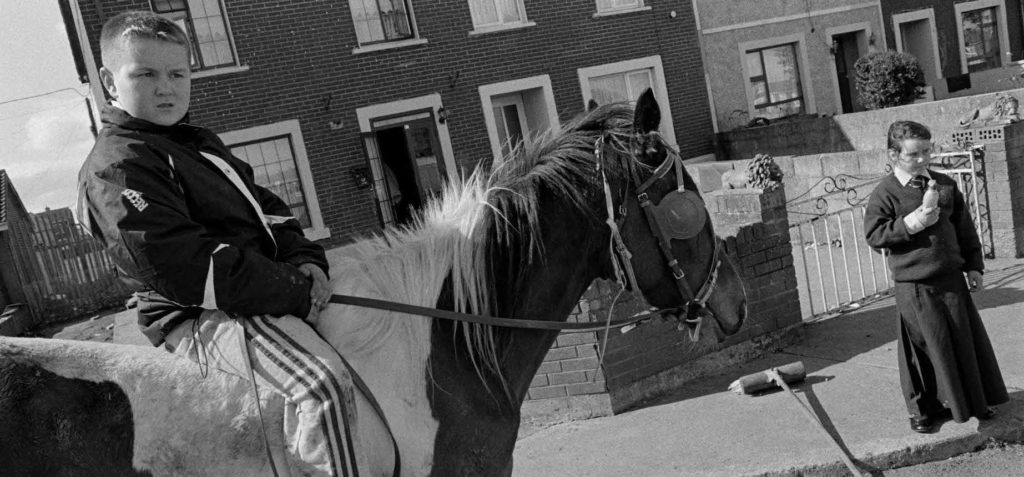
One day, a handful of men from Moyross let me tag along as they took a horse to the river for a swim, part of a regular exercise routine for training race horses. After leaving their estate and crossing the Kileely Road, we wound our way through low-lying brush toward the Shannon, a handsome brown and white pinto in tow.
Results of the national Leaving Certificate Examination, Ireland’s university matriculation test, had just been released, and as we approached the river, we passed groups of teenagers getting drunk and smoking in small celebratory huddles. When we reached the water, Paddy, whose horse we were accompanying, let out a long stretch of rope from the animal’s reins and briskly scaled the side of a railroad trestle stretching eastward toward St. Mary’s Park.
From this perch, he coaxed the horse into the river, using the rope to lead until it left the shallows and was treading water directly beneath him. Then, tugging sharply on the reins, Paddy repeatedly spurred the horse to breach the surface, lunging upward with its knees bent, propelled by powerful hind legs. Paddy’s compatriots looked on approvingly at his skill in handling the pinto. When it was determined that the animal had been swimming long enough, Paddy tossed the rope to his friends onshore, scrambled out a bit further on the tressel and executed a flawless jackknife into the cool blue drink.
A trainer takes a horse for a sulky ride. Sulkies are small passenger carts used for racing.
This bucolic scene of human-animal bonding seemed to contradict many locals’ opinions about having horses in their communities. Most council tenants I spoke with told of their struggles with discrimination—how, once people saw your address, the job offers would dry up—and the contempt they felt from police and people outside the estate. In turn, many older residents placed blame for the degradation—and notoriety— of their neighborhoods on the “anti-social behavior” of young men and boys. Unlicensed horses, a minor but visible civil disorder, were easy scapegoats for unlawfulness in general. “If you’re going sulky riding in Moyross,” a Ballinacurra Weston local once cautioned me as I went to meet another Moyross trainer who’d promised to take me riding, “you’d better bring your helmet and a bulletproof vest.”
•••
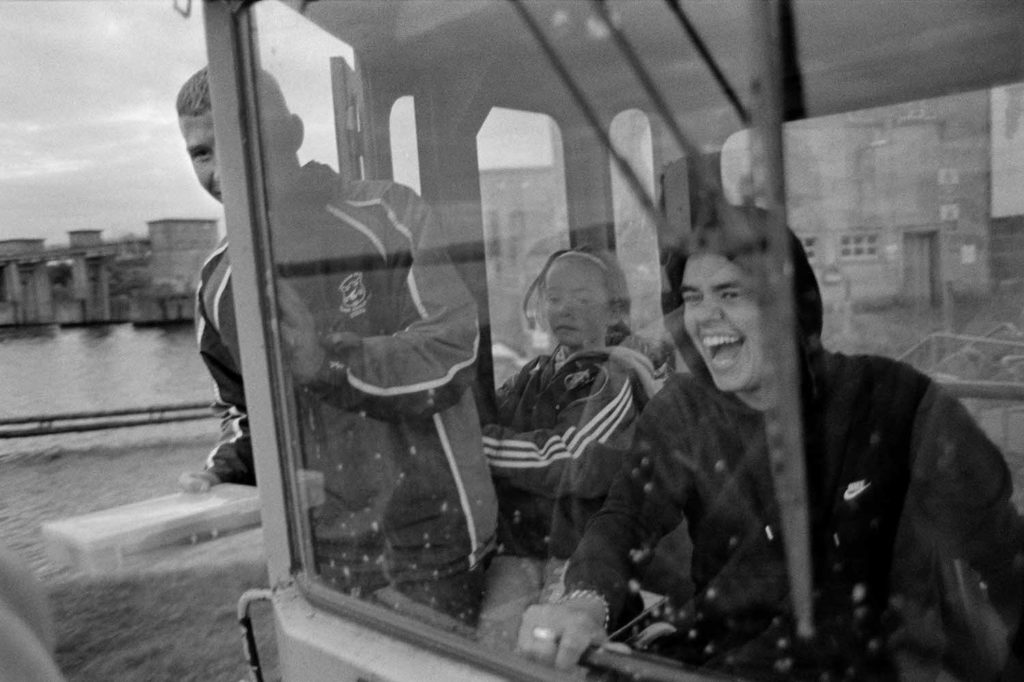
Despite such conflicts, Limerick’s embattled council residents pushed on, bathed in the furious light and withered beauty of Western Ireland, insistent on their right to stay—or go—but not to be pressured either way. And though many locals dismissed them as an eyesore, nuisance or menace, the horses’ enduring presence stood out as an act of defiance, not only against the law forbidding the riding and raising of horses within city limits, but as a stand taken on the brink of something larger and less distinct: the march of modernity on a country still ambivalent about whether or not it wanted any.
Globalism had dragged this perennially poor nation out of backwater status and into the world economy, and the boom had been a blessing to most, raising the standard of living in a country that had long lagged behind the rest of Western Europe. But for certain segments of Irish society—the itinerant travellers and council-housed families who were the last to see the benefits—that promise never fully materialized. From this vantage, horses were a link to the past’s reliability, like some intrinsic amount of traditional self-sufficiency reasserting itself in the lives of each new generation. Their value was not measured in euros; but rather it was tied to something much older and more permanent. Call it pride.
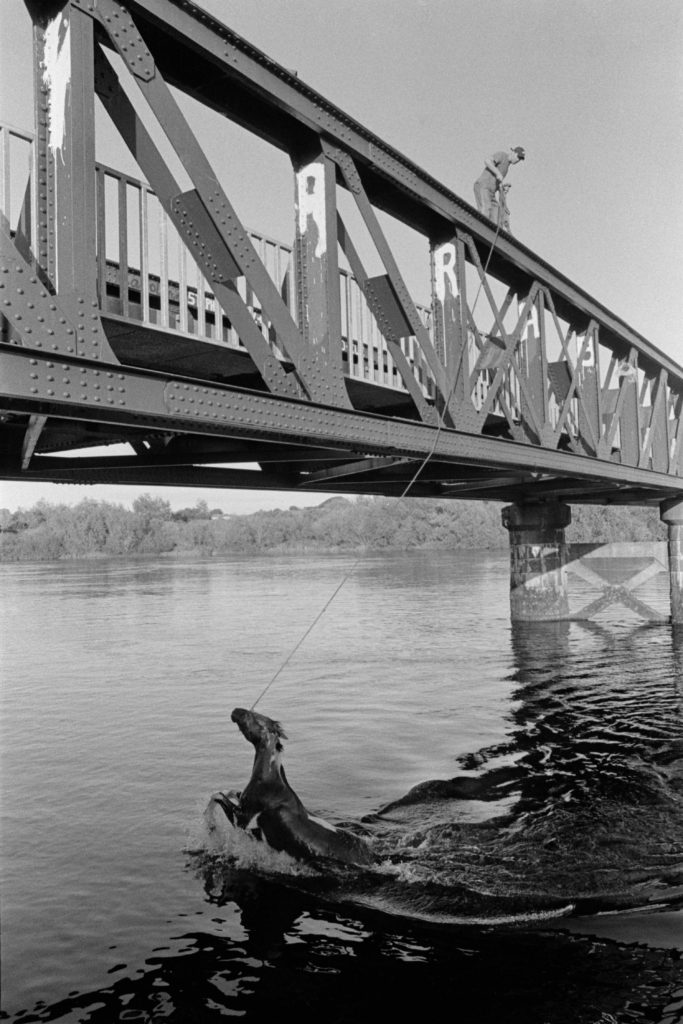
Contributor
Rian Dundon is a photographer and editor. His books include Changsha and Fan. His work has appeared in the New York Times, Mother Jones, the Washington Post and Newsweek. He is a contributing editor at the Economic Hardship Reporting Project.
